Types of Cider
Sweet Cider: Straight from the press (blender)
Cider Soda: During active fermentation, the cider is fizzy, some of the sweetness is taken away due to mild fermentation, with a hint of alcohol. This stuff is *really* tasty. Better than sweet or hard cider in my opinion. At least of the stuff I have made so far. Just need to be careful: either keep under an airlock, keep it loosely capped, or regularly release pressure, otherwise bottles might explode.
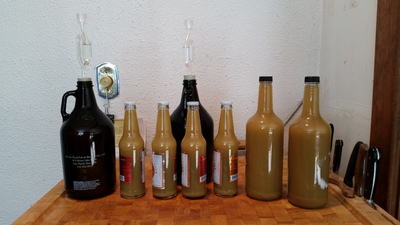
Hard Cider: The cider after it has completely fermented. Very dry because pretty much every last bit of sugar has been converted to alcohol.
Pressing the Cider
I am using a Vitamix blender to crush the apples. The process I use is to:
1) Pick the apples from the tree, ideally after it hasn't rained for several days so that naturally occurring yeast has a chance to build up on the apples.
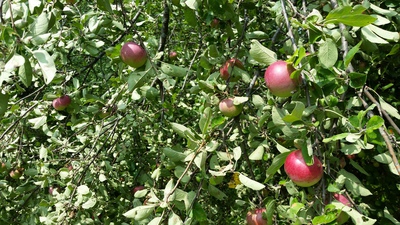
2) Disinfect work surfaces, blender, containers, knife, hands, etc. using IO Star no-rinse sanitizer.
3) Halve apples, remove stem, and scoop core/seeds with a spoon.
4) Chop apples
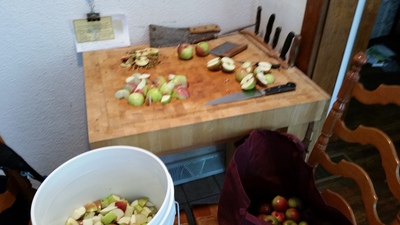
5) Blend, adding liquid (cider or water) to make blending easier.
6) For sweet cider, use a nut milk bag to strain cider from the apple puree. Or, for hard cider, place the puree directly into a sterilized fermentation bucket sealed with an airlock.
Fermenting the Cider
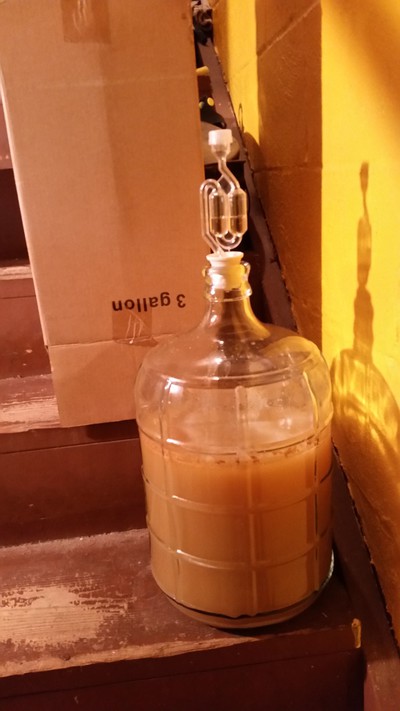 1) Place unpasteurized apple puree into a sterilized fermentation bucket sealed with an airlock.
1) Place unpasteurized apple puree into a sterilized fermentation bucket sealed with an airlock.
2) Leave alone for 3-5 days. This gives the natural yeast on the skins a chance to permeate and multiply in the cider liquid. Maybe punch it down once per day to stir up the floating apple bits that are exposed to air. **Note: steps 1 and 2 might be better served by starting with a small pied du cuvée, then adding that to fresh-pressed cider.**
3) Strain the cider from the solids, squeezing out as much liquid as possible using a nut milk bag.
4) The cider is naturally sparkling cider soda at this stage, and should remain so for several days as the sugar slowly ferments into alcohol. It might be nice to try putting it in a bottling bucket (a plastic bucket with a spigot) at this stage, and over a week or so pour glasses of the fermenting cider.
5) Primary fermentation: Put cider into a glass carboy or fermentation bucket sealed with an airlock. I don't think it is necessary to fill the carboy at this stage because co2 from active fermentation should fill any airspace in the carboy. Primary fermentation should take maybe a week.
6) Secondary fermentation: Transfer to another carboy or fermentation bucket using a siphon using a racking cane to ensure that the sediment is left in the bottom of the primary. Seal with an airlock.
7) Leave in secondary fermentation for a few weeks to months.
8) Transfer to bottles, possibly adding an ounce of cane sugar (dissolved in boiled water) per gallon first in order to carbonate the bottled cider. Better yet, maybe add some fresh-pressed cider for it's sugar content.
Batches
Hard Cider (C1)
On my first batch of hard cider, I made a few mistakes. I fussed with it too much, not a big deal. I used a faulty airlock (hole) for several days during primary fermentation, maybe not a big deal because the cider was actively exhaling out the hole. I kept the seeds in the apples, also not a big deal, but seeds contain some bad stuff that I would prefer to keep out of the cider. Also, when I transferred to secondary, I wanted the carboy to be full so I added water, and you can taste the fact that it's a little watered down. I bottled several bottles with screw caps and no sugar. The unsugared cider is extremely dry, probably too dry. After 1 month and 5 days since picking the apples, I added sugar and bottled. I expected the sugar to add carbonation, however no carbonation occurred, at least as of a few days later. I'm guessing all the yeast died, which is a good thing. The sugar instead took away some of the excessive dryness, and now it tastes quite good, although you can taste the fact that it is slightly watered down.
The cider is cloudy with no carbonation. Very dry, doesn't taste very apple-y, and has a bit of sour (as in sour beer) taste. Noticeably watered down. Drinkable and enjoyable, not bad for a first run. The biggest room for improvement is not to water it down. I like the sour taste, but could be minimized. (Note: After resting in bottles for a week or so, the 'watered down' taste is gone, and the sour taste is very agreeable.) After tasting some less messed up ciders, the sour taste feels like a bad sign. Not terrible, in fact gives it a uniqueness that I might miss when it's gone, but not ideal. Update: 4/30/20 - I had a bottle of the cider, it probably tasted about the same. Not bad, slightly funky/sour, slightly watered down, but somewhat drinkable in 1-bottle quantitites. Not exactly good, but not terrible.
Cider Soda (CS1)
I bottled some of C1 during mid-primary fermentation using twist caps. It was really tasty stuff, although I had to constantly release pressure from the bottles. Sweet, slightly fizzy, slightly alcoholic version of C1 (before it fermented all the way). Really tasty and fun to drink, but challenging to tame the carbonation.
Grape Cider (GC1)
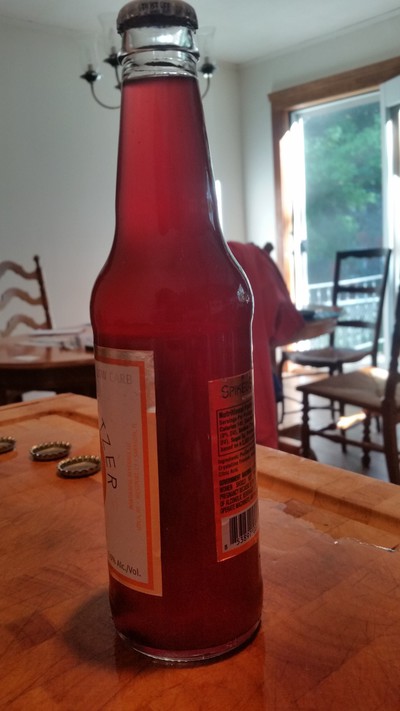 I made a small batch of cider with a bit of wild grape juice added to give it a little red wine character. The mistake I made here was that I strained the cider from the solids without letting the yeast build up in the cider first. This meant that the airlock never actively bubbled. After a few weeks, the sugar content was gone, so it seems to have fermented. The grape cider, at the time of bottling, smelled like dirty socks, but tasted ok. After maybe 3 weeks, this has been bottled without adding sugar. After bottling, the bad smell went away, and the wine tastes really simple, clean, and right in between dry and sweet. I'm trying to place the taste. It could be a light rosé wine, or maybe a wine you might get at the farmer's market.
I made a small batch of cider with a bit of wild grape juice added to give it a little red wine character. The mistake I made here was that I strained the cider from the solids without letting the yeast build up in the cider first. This meant that the airlock never actively bubbled. After a few weeks, the sugar content was gone, so it seems to have fermented. The grape cider, at the time of bottling, smelled like dirty socks, but tasted ok. After maybe 3 weeks, this has been bottled without adding sugar. After bottling, the bad smell went away, and the wine tastes really simple, clean, and right in between dry and sweet. I'm trying to place the taste. It could be a light rosé wine, or maybe a wine you might get at the farmer's market.
Really well balanced, simple, underpowering, light wine-like taste. I'm very tempted to make more of this stuff. Doesn't taste like cider at all, but really bumps up the quality of the light grape juice.
Next Batch
Next time I would like to avoid all of the above mistakes. Also I would like to try keeping a batch of cider soda in a bucket with a spigot to be enjoyed as it ferments. At some point I would like to try killing off all bad stuff with sulphites and pitch a beer yeast. Just to see how different it ends up from the all-natural approach. Maybe a small batch. Also, I have been fermenting at summer basement temperatures. I could probably ferment at warmer temps.
Mistakes to Avoid
* Don't add water to increase volume
* Don't rinse apples or strain the cider right away if using natural fermentation. It needs to ferment with the skins if using natural yeast.
* Don't process the apples immediately after picking. Give them a week or even months to mature, increasing the sugar content. (I'm way to impatient to obey this one).
* Avoid oxygen exposure as much as possible. My current processing involves a lot of oxygen exposure.
* The cider spend lot of time exposed to air. A faster grinding/pressing process or having help would lessen this a bit.
* It seemed like pressing cider immediately after grinding was a little easier and more effective than pressing 3 days after grinding. So maybe it makes sense to do a small pied de cuvée rather than try to build yeast in the entire mass of apples. This would also help reduce some of the oxidation because the surface apple mush turns dark over the 3 days. (Bingo - I just found this. Really interesting that he mentions the acetone smell which plagued my natural wine making attempts.).
Notes
* 50 apples made 1 gallon of cider.
* 15 medium-sized apples yielded 10.5 cups of apple mush, which made 6.5 cups of sweet cider.
* "allow the fermentation itself to generate the carbon dioxide by 'natural conditioning'. One way of doing this is by racking and bottling the fermentation early, say at a gravity of 1.010, and allowing the cider to finish fermenting and to mature in the bottle."
* This is interesting: "Sweeter ciders are slowly fermented and repeatedly racked (moved to new containers) to strain the yeast that feeds on the cider’s natural sugars. Dryer ciders (meaning they contain less sugar) allow the yeast to consume the majority of cider’s natural sugars and result in a less sweet drink with a higher alcohol content."
* Starch/sugar in apples - Apples start out starchy, and eventually the starch converts to sugar. You can use the starch-iodine test to get an idea of how far along the apple is in this process. As I understand it, keeping apples in storage after they are picked for 5 days to several months helps move the conversion process along.
* Picking apples in France sometimes involves picking up apples from the ground: (Link here)"At harvest time the Sallins' trees are given a good shake and the apples that drop are then vacuumed up. It does not matter if they are bruised, says Mr. Sallin, for they are made into cider immediately."
Questions
* This video says they don't add anything (yeast, sulfites, sugar?), how do they manage to ferment for 5 months and end up with a carbonated product? Hmm, they could add additional cider to add sugar. But how come their yeast survives that long when mine didn't? Lower temps?
8/29 - process started, chopped apples
8/30 - carboy is fullish
Second Roundage (C2)
My friend A was kind enough to let me pick apples at his house. He's got three beautiful apple trees with all kinds of apples, big ones too. Hopefully I can turn it into a proper batch of hard cider. And sweet cider. And everything in between - it's a *lot* of apples. Two big bags of apples pureed into 6 gallons of mush, and that was only roughly half of what I collected:
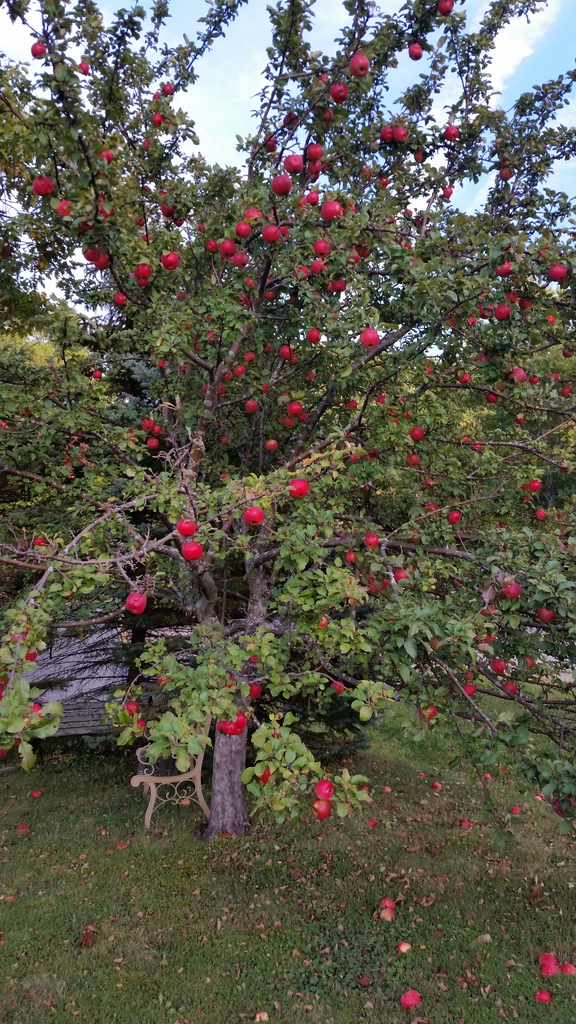
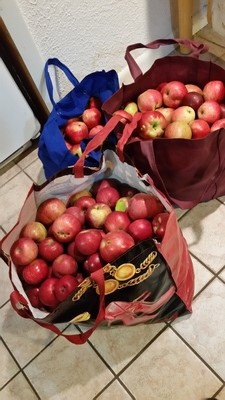
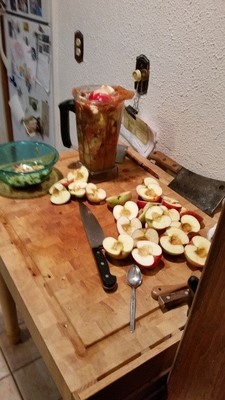

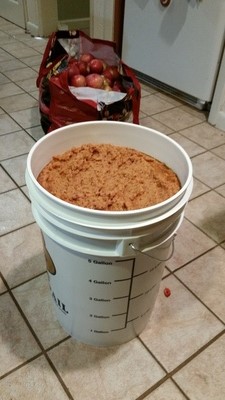
After 3 days of letting the natural yeast activate in the 6 gallons of apple mush, I used my poor overworked nut milk bag to juice maybe 3.3 gallons of cider. I then rinsed, ground, and juiced enough apples to fill the carboy to roughly 5 gallons total. Within a few hours, tiny bubbles have started forming at the surface, and the airlock is bubbling slowly, but progressively faster.


Three days later the cider is fermenting aggressively. I removed 12 ounces of cider because it started to foam over. The cider at this point tastes disgustingly sweet. I guess I'll just let it do it's thing. I'm curious to see if the natural yeasts will survive at higher alcohol levels making a dry cider, or if they will die off before all the sugar is consumed and leave behind a sweeter cider.
c2:
10/07 - Picked apples at A's house
10/08 - Ground apples using the Vitamix
10/10 - Painstakingly strained 5 gallons of cider
11/3 - The cider has been bubbling steadily in the cool basement. The best thing probably would have been to just let it do it's thing, but I fussed with it, for a couple of reasons. First, impatience. Second, I have another batch of apples ready to go, but first I need to free up the 5 gallon carboy. So I transferred 3 gallons to the 3 gallon carboy and bottled the remaining cider (C2.0). C2.0 is cool stuff because it contains *only* apples. According to hydrometer readings, I think the cider is only 1-3% alcohol. So I added some beer yeast to the 3 gallon batch and placed it on the ground floor where it's a little bit warmer.
Measurements
Fresh-pressed cider in the fridge reads 1.05, which equates to maybe 6.56% alcohol potential.
Third Batch (C3)
I picked some more apples on 10/25/15 from A's house. I put the pristine apples into storage, but 50 or so apples were a little chewed up or beaten up. I went through and removed any holes or spots from the apples, and discarded 2 ugly apples. The rest were rinsed and went into the insinkerator. I squeezed them through a (bigger) nut milk bag. 2 bagfulls, not quite full, squeezed a full gallon of cider. I'm curious to see if using rained on and rinsed apples will ferment despite the fact that most of the natural yeast could have been washed away.
Fourth Batch (C4)
10/25 - Picked lots of apples at A's, put into cool storage.
10/27 - Picked a few more apples in Clifton Park. These had some black splotch on them, so I gave them a good scrub and rinse.
11/7 - Ground all the apples in the insinkerator. Strained through the larger bag. The entire process took around 2 hours to make 5 gallons of cider. Not bad. Although straining is still a lot of hard work. Added a Belgian beer yeast and left on the ground floor (temp in the high 60's).
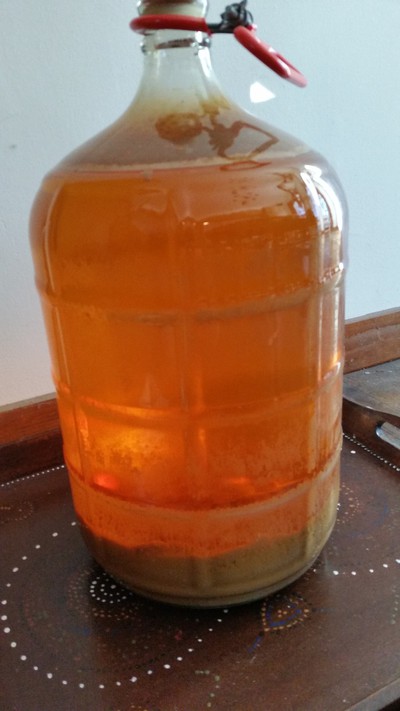 2/14 - Bottled the five-gallon cider carboy. I had put bottling off mostly because I didn't have enough empty bottles (because they are storing my poisonous-tasting c2.5). Bottling was difficult. The carboy bottom had several inches of sediment, but the siphon accounts for a only a half inch of sediment. And there was no easy way to suck the cider from several inches up. Meanwhile on the other end, the bottle filler would fill relentlessly unless I used my 'other hand' (which was clearly busy trying to keep the siphon out of the carboy sediment) to hold the filler off the bottom of a bottle. Eventually I figured out that I could stuff the bottle filler into the handle of a growler to hold it steady while I dealt with the sediment sucker in the carboy. Seems like a two man job to be sure. I filled a case of bottles plus some growlers. I probably did not get anywhere close to 2 gallons of end-product due to the large pile of sediment and cider that was wasted on account of accidents. On first tasting, the cider is... ok. Definitely drinkable. It has funk to it, which could be a positive attribute associated with the Belgian yeast I used. For now let's call it a positive attribute, although so far my previous ciders have only gotten worse after sitting in bottles. This time things will be different, I just know it! After bottling, I put the bottles in old, war-torn 6 packs which I carried to the basement. On my second trip downstairs the cardboard bottom fell out of a six pack, and six bottles fell. One onto my foot (saved!), one shattered, one (amazingly) survived but the cap popped off. Leaving 4 full bottles and a big nasty mess to clean up at the bottom of the basement stairs.
2/14 - Bottled the five-gallon cider carboy. I had put bottling off mostly because I didn't have enough empty bottles (because they are storing my poisonous-tasting c2.5). Bottling was difficult. The carboy bottom had several inches of sediment, but the siphon accounts for a only a half inch of sediment. And there was no easy way to suck the cider from several inches up. Meanwhile on the other end, the bottle filler would fill relentlessly unless I used my 'other hand' (which was clearly busy trying to keep the siphon out of the carboy sediment) to hold the filler off the bottom of a bottle. Eventually I figured out that I could stuff the bottle filler into the handle of a growler to hold it steady while I dealt with the sediment sucker in the carboy. Seems like a two man job to be sure. I filled a case of bottles plus some growlers. I probably did not get anywhere close to 2 gallons of end-product due to the large pile of sediment and cider that was wasted on account of accidents. On first tasting, the cider is... ok. Definitely drinkable. It has funk to it, which could be a positive attribute associated with the Belgian yeast I used. For now let's call it a positive attribute, although so far my previous ciders have only gotten worse after sitting in bottles. This time things will be different, I just know it! After bottling, I put the bottles in old, war-torn 6 packs which I carried to the basement. On my second trip downstairs the cardboard bottom fell out of a six pack, and six bottles fell. One onto my foot (saved!), one shattered, one (amazingly) survived but the cap popped off. Leaving 4 full bottles and a big nasty mess to clean up at the bottom of the basement stairs.
Carbonation
C1 - I don't quite understand why, but this became very dry within a little over a month. I bottled it, and the bottles didn't build up any significant carbonation.
C2 - After a month of primary fermentation, the cider was still very sweet (it went from something like 1.05->1.04 if my measurements were correct). I transferred most of it to a smaller carboy, but bottled the remains. I put some bottles in the fridge, some in the basement, and some in the kitchen. The different temperatures affected the carbonation level. A few weeks later, the fridge bottles had no significant carbonation. The kitchen bottles tasted delicious and were perfectly carbonated, so that when opening them up, they foamed up to just over the rim. I opened and recapped some of these to ensure they wouldn't blow up. I also pasteurized some. As much as I am loathe to pasteurize, the pasteurized bottle still tasted really good. Lessons learned: fermenting at room temperature is good. Bottling with sugar and yeast is difficult, although refridgeration and quick drinking can help with that. Or perhaps measuring the specific gravity, though I haven't tried this approach. Starting gravity: (probably) 1.04-1.05. Final gravity: 1.002. ABV: 5-6.3%.
Links
- Awesome podcast about making hard cider with natural fermentation (found here).
